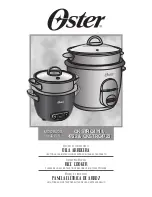
13
12
English
Tips on making delicious rice
Select high quality rice and store it in a
cool location.
Choose freshly polished, glossy rice with a
uniform grain size. Store rice in a cool, dark, well-
ventilated place.
Carefully measure the rice with the
supplied measuring cup.
1 cup (level filling) is
approximately 0.18 L. Use the
supplied measuring cup for
rinse-free rice as well.
Rinse the rice quickly.
Pour rice in the inner pot and add plenty of water.
Lightly stir the rice and discard the water quickly.
Use cold water and quickly rinse the rice so that
the rice does not absorb the starchy water.
When cooking germinated brown rice,
whole rice, or semi-polished rice, select
the “Multigrain” menu.
Cooking rinse-free rice
• Add the rinse-free rice and water, and then stir
well from the bottom so that every individual
grain of rice becomes immersed in the water.
(Merely adding water to the rice will prevent
it from soaking in the water and may result in
improperly cooked rice.)
• If the added water turns white, we recommend
you wash the rice thoroughly by replacing the
water once or twice. (The water turning white
is due to the starch in the rice and not its bran;
however, cooking it with the starch left in the
water may result in burned rice, the contents
boiling over, or improperly cooked rice.)
Adding other ingredients to the rice
The total amount of ingredients should be no more
than 70 g per cup of rice (the “Porridge” menu is
excluded). Stir in any seasoning well and then add
the extra ingredients on top of the rice. If other
ingredients are to be added to the rice, be sure to
use no more than the acceptable maximum amount
(refer to the table below).
Type of rice
1.0 L (5.5-cup)
type
1.8 L (10-cup)
type
Brown
3 cups
5 cups
Porridge • Firm
0.5 cups
1.5 cups
Mixed
4 cups
6 cups
Sweet
3 cups
5 cups
• Do not open the lid during cooking to add other
ingredients.
• Add water prior to adding the ingredients.
Adding water after the ingredients results in the
cooked rice being too firm.
• The following cases may result in improperly
cooked or burned rice.
• When too much of seasonings such as soy
sauce, sweet cooking rice wine, etc. are
added
• When seasonings have sunk to the bottom
• When ketchup or tomato sauce is added
• When other ingredients are mixed with rice
• When adding ingredients to porridge, add
water to the rice so that the water level after the
ingredients are added is not over the top line of
the “Porridge” scale.
Add water according to the type of rice
and your personal preference.
Amount of water to add
Type of rice
Corresponding scale (Use the
corresponding scale on the inner pot
as a guide and add water according
to your personal preference.)
Plain/White
Quick
“Plain/White” scale
Ultra
Mixed
“Ultra” scale
Express-Limited
Cups
“Express-Limited Cups” scale
Eco
“Eco” scale
Multigrain
More or less water to “Plain/White”
scale
Brown
GABA Brown
“Brown” scale
Porridge
Hard porridge: “Porridge • Firm” scale
Soft porridge: “Porridge • Soft” scale
Sweet
“Sweet” scale
Long-grain
“Long-grain” scale
Read P.14 to 15 for preparations
before cooking rice and P.16 to 20 for
how to cook rice.
• When cooking rinse-free rice, use the “Plain/
White” scale as a reference but add a little extra
water (until it just covers the corresponding line).
• If you choose to use more or less water than the
recommended amount, do not deviate from that
amount by any more than 1/3 of one line.
• When cooking germinated brown rice, whole rice,
or semi-polished rice, use the “Plain/White” scale
as a reference.
• When cooking steamed sweet rice, use the
“Sweet” scale as a reference.
When cooking sweet and non-sweet rice mixed
together, use the scale between “Plain/White”
and “Sweet” as a reference. (In this case, add a
little extra water to the level used when cooking
only sweet rice.)
•
If the amount of water to add is specified on
a package of germinated brown rice or multi-
grain rice, follow those directions and add water
according to your personal preference.
Cooking brown rice and/or multigrain
brown rice mixed in with white rice
• Multigrain brown rice is brown rice mixed with
other grains.
• If the rice to be cooked includes more brown
rice and/or multigrain brown rice than white rice,
use the “Brown” menu.
• If there is an equal amount of brown rice or
multigrain brown rice and white rice, or there
is more white rice than brown rice or multigrain
brown rice, use the “Plain/White” menu. (The
brown rice or multigrain brown rice should
be soaked separately for 1 to 2 hours before
cooking.)
Cooking sweet rice
When cooking sweet rice, select the “Mixed/
Sweet” menu.
Wash the rice, and then level it out so that all of
the rice is under water.
Cooking other grains together with white
rice
• The amount of other grains rice should equal
less than 20% of the volume of the white rice.
• The other grains should be placed on top of the
white rice. Mixing them together may result in
improperly cooked food.
Cooking other grains together with brown
rice
• Always use the “Brown” menu.
• The maximum acceptable amount for the
combination of brown rice and other grains is 3.5
cups with the 1.0 L type and 6 cups with the 1.8
L type.
Cooking long-grain rice
• When cooking long-grain rice, select the “Long-
grain” menu. When cooking seasoned rice with
various ingredients using long-grain rice, select
the “Mixed/Sweet” menu. Selecting any other
menu may result in improperly cooked food.








































